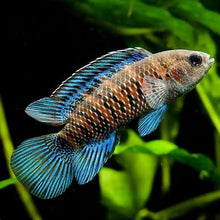Scientific name: Badis Badis
Native to the Ganges- River system, from the Yamuna River in Himachal Pradesh state, India, to its delta in Bangladesh. It is also known from Ganges tributaries in Nepal, while in India there are additional records from the Mahanadi River system in Chhattisgarh and Orissa states, and parts of Assam state including the city of Guwahati, Kaziranga National Park, and the Dibru River basin.
When Hamilton described this species he did so only from field notes and drawings, therefore Kullander and Britz (2002) designated a neotype in order to avoid confusion with similar-looking congeners.
Neotype locality is ‘shore of Tumapao River close to Duma village (Ganges River drainage), about 65 kilometers north-north east of Calcutta, West Bengal, India, 22°58’03″N, 88°49’49″E’.
Badis Badis will thrive in a planted aquarium with relatively mild to moderate water flow and is generally peaceful with other species of fish. Though it is a micropredator, its small size makes it safe with virtually any fish or invertebrate that is too large to be considered prey. It can be housed with some invertebrates such as snails and larger shrimp, but it may eat the fry and juveniles of most Caridina and Neocaridina shrimp of any other small invertebrates that will fit in its mouth. Badis Badis is somewhat timid compared to more boisterous fish, so it is necessary to make sure that this badis is not outcompeted for food.
Difficulty in keeping: Easy
Maximum size: 5-6cm Males 4-5cmFemales
Selling size: 2-4 cm and above
Temperature: 24 – 28 °C (25°C preferred)
pH: 6-7.8 Our fish are bred and grown at a ph between 6.0 and 7.5
Diet: Primarily carnivorous and apparently feeds mostly on benthic invertebrates in nature. In the aquarium live and frozen foods such as Brine shrimp, Daphnia and Grindal worms should be offered regularly although most specimens will also learn to accept dried alternatives with pelleted products generally preferred to flake.
Disclaimer: Photos are taken of our own fish and usually the breeding parents, photos are for reference only and actual fish you will receive might slightly vary. In this instance the photo of the male is a stock photo. The other 2 photos are out own fish.






